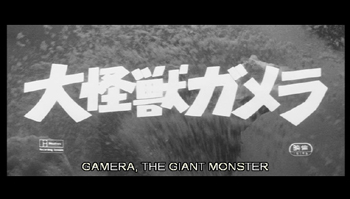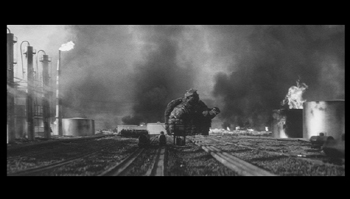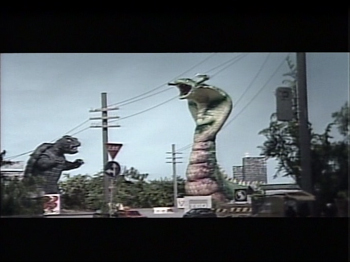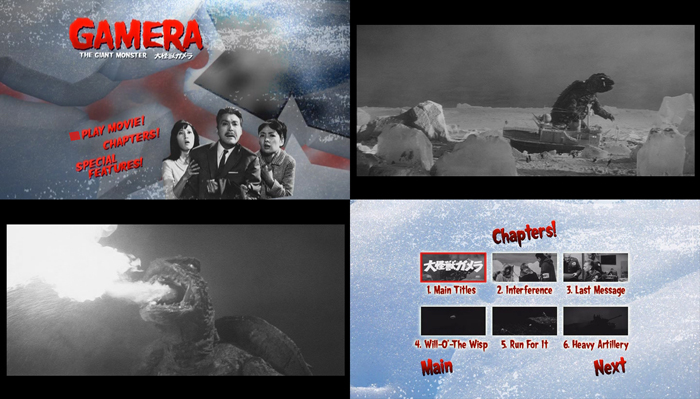 The original Japanese version of GAMERA is now finally available on the Region 1 DVD GAMERA THE GIANT MONSTER from Shout! Factory. © 1965 Kadokawa Pictures, Inc.
The original Japanese version of GAMERA is now finally available on the Region 1 DVD GAMERA THE GIANT MONSTER from Shout! Factory. © 1965 Kadokawa Pictures, Inc.The First Release From Shout! Factory’s Gamera DVD Series Will Please Fans Author: John “Dutch” DeSentis Official Site: Shout! Factory Special Thanks to August Ragone and Cliff Macmillan
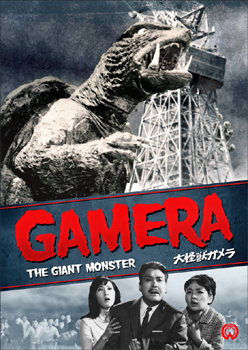 DVD cover art for GAMERA, THE GIANT MONSTER. Photo courtesy of Shout! Factory. © 1965 Kadokawa Pictures, Inc.
DVD cover art for GAMERA, THE GIANT MONSTER. Photo courtesy of Shout! Factory. © 1965 Kadokawa Pictures, Inc.While Gamera’s popularity has never been quite on the level of Godzilla, the giant flying turtle has no doubt enjoyed his share of accolades in Japan and in the 1960’s was very much a competitor of Toho’s monster king. Gamera’s popularity was revived in the 1990’s with Shusuke Kaneko’s acclaimed Heisei trilogy of films. While most fans prefer that particular incarnation of the titan terrapin, many still look fondly upon the friendlier movies of yesteryear. While most of the films in the classic Gamera series are geared towards children, GAMERA THE GIANT MONSTER (Daikaiju Gamera, 1965) is quite serious and depicts the title character as a menacing, deadly beast. In this first entry into the series, Gamera attacks Tokyo and kills countless citizens by trampling, crushing buildings, and incinerating them. Oddly, Gamera also rescues the main child character in the film from a fall to certain death (caused by the monster no less!). This leads to the child’s affection for the kaiju turtle; so much so that the social misfit completely ignores all the death and destruction caused by the fire-breathing beast! Shout! Factory has acquired the rights to release all eight Showa-era Gamera films produced by Daiei from 1965-1980 and has begun to issue those classics on DVD with a deluxe treatment. If this first title is any indication, these discs will be incredibly done and should (hopefully) satisfy the giant turtle’s fans here in America.
THE MOVIE
So just what can fans expect? Well to begin with, this DVD was sourced from a brand new anamorphic widescreen high definition print provided by Kadokawa Pictures (the company which Daiei merged with). This same source was used for the Japanese Blu-ray release. In a word, the print looks incredible. Watching on a hi-def set with a Blu-ray player, this movie holds up marvelously as an upconverted DVD. The movie contains the original Japanese print only with removable subtitles. It is obvious that Daiei kept this movie stored very well to begin with, as an HD transfer is majorly dependent upon the condition of the source material. The worst looking scenes in the movie tend to be newsreel shots and source footage (such as a shot of a Pan America Plane and some volcano eruption footage). This is to be expected as there is only so much that can be done with materials of that sort. The studio footage, however, is virtually flawless especially for a black and white movie. There is nary a scratch on the print. It really casts a pale shadow on the recent hi-def transfer of GODZILLA (Gojira, 1954) which wasn’t so much cleaned up as it had its camera focus softened. It is a shame that this was not made available on Blu-ray here as this print certainly will look spectacular in full 1080p.
Honestly, GAMERA THE GIANT MONSTER is a flawed film (as are many movies of its type). The quality of the print, however, will really open new eyes to this film and likely to the rest of the Gamera series as well (as of this writing, GAMERA VS. BARUGON has been released and looks positively spectacular). Firstly, it is a lot easier to appreciate the great details on the Gamera suit which here looks much more fierce than the friendlier looking version to come later. There are many points in the film where the texture of the monster’s various parts is emphasized (including the opening credits) and these fine details can be closely examined and enjoyed in high definition. Also benefiting immensely from the same is the quality of the miniature work. Here, it is possible to truly take in and realize the extent of the Tokyo miniature set. It is clear that the special effects crew were conscious of the quality of Eiji Tsuburaya’s work at Toho and labored to try and produce something that would make the old man proud as they no doubt looked up to him. The audio quality also holds up surprisingly well. The original sound effects as well as Tadashi Yamauchi’s classic score sound as crisp as possible in Dolby Digital 2.0.
THE PACKAGING
 Cover to the insert booklet, featuring the original Japanese poster art. © 1965 Kadokawa Pictures, Inc.
Cover to the insert booklet, featuring the original Japanese poster art. © 1965 Kadokawa Pictures, Inc.The artwork for the DVD insert is strikingly done with a monochromatic image of Gamera attacking Tokyo Tower and the main characters with the word GAMERA in red. This succeeds in making the creatures name pop right out and also shows the class with which Shout! Factory is treating the subject matter. There are no silly looking images to be found ala the unlicensed Alpha Video versions. The backside contains the expected summary of the movie and special features. The inside of the artwork (and showcased through a transparent clamshell case) contains an illustration of Gamera’s anatomy. It is adapted from an illustration by Shogo Endo from the book called An Anatomical Guide to Monsters (first published in 1967) and has been updated by Jolyon B. Yates. It is a fun little extra added to an already well done package. Inside the case, there is a twelve page booklet which uses the original Japanese theatrical poster as its cover. The booklet begins with an essay from late Gamera series director Noriaki Yuasa which is translated from the booklet of the 2002 Gamera DVD box set that came out in Japan. It gives a wonderful insight into how the director felt about his work and leaves little doubt as to where his heart was when filming. Mr. Yuasa, who sadly passed away in 2004 from a stroke, was truly a special man and all the fans who had the great fortune of meeting him (including this author) will always attest to that. Following that is a set of biographies of characters in the film. While a nice touch, the biggest disappointment is that the booklet is surprisingly lacking on information about the actors themselves as well as the staff. While much of the information regarding the cast and staff is covered in the commentary, it is always nice to have a physical reference as well. The booklet then contains a redux of the previously mentioned anatomical illustration and is rounded out by acknowledgments and thanks to the individuals who contributed to the product.
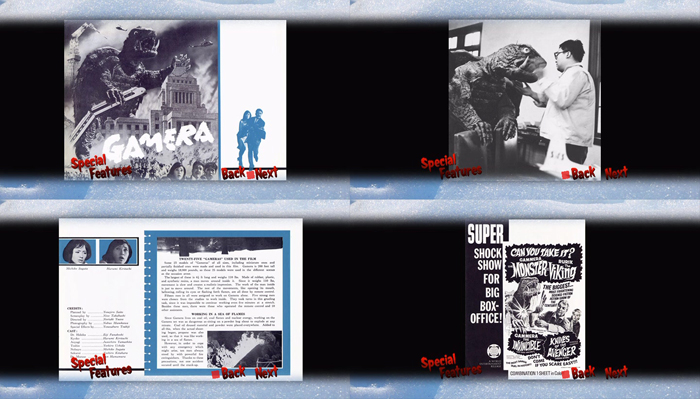 Special features on the DVD include stills, production photos, and promotional materials from the film. © Kadokawa Pictures, Inc.
Special features on the DVD include stills, production photos, and promotional materials from the film. © Kadokawa Pictures, Inc.THE SPECIAL FEATURES
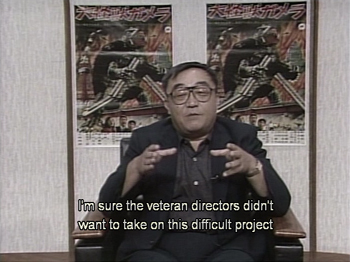 GAMERA director Noriaki Yuasa discusses his work in an excellent 1991 documentary included on the GAMERA THE GIANT MONSTER DVD. © Kadokawa Pictures, Inc.
GAMERA director Noriaki Yuasa discusses his work in an excellent 1991 documentary included on the GAMERA THE GIANT MONSTER DVD. © Kadokawa Pictures, Inc.The anchor of the special features is an audio commentary by August Ragone, noted Tokusatsu historian and author of the book Eiji Tsuburaya: Master of Monsters. The commentary is very well done and presents a balance of information about the production of the movie and the actors and staff that appear throughout. When Gamera is not on screen, much time is spent identifying the players on screen and their connections with other Japanese cinema (some including Toho’s Godzilla series). The commentary appropriately begins by establishing the climate of the heightened nuclear arms race and its connection with Gamera. Although primarily regarded as children’s fare later on, this first film did make an attempt to address the global issue of nuclear arms and its implications on the nation of Japan albeit to a lesser extent just as GODZILLA did eleven years earlier. A common joke among Kaiju Eiga fans is the proliferation of bad western actors at times throughout the history of the genre. The commentary makes humorous mention of the fact that some of the “actors” used in these films were literally taken from hotel lobbies. The army characters in the film were likely pulled from a real air force base. Another great piece of information is why Gamera is a giant turtle and what the turtle itself means to Asian culture. It actually makes this outlandish monster concept much more understood. All in all, there are so many tidbits to listen for such as the the supposed origin of Gamera concept, an amusing anecdote about director Yuasa and his crew in which Eiji Tsuburaya is mentioned, the rather shocking (and somewhat disgusting) details of the cancelled film A SWARM OF BEASTS: NEZULLA about giant rats, and a nice ode at the end to the director as well as the late Guy Tucker. The only puzzling thing about the commentary track is that there is a noticeable dip in volume when switching from the standard audio track and one has to turn up their TV a bit to hear it at the same level.
“A Retrospective Look Back at Gamera” is another major feature on the disc. This is actually culled from the 1991 laserdisc box set “The Gamera Preservation Project” from Daiei video. Despite the age of the short, most fans have probably never seen this translated so it will no doubt be a treat. It contains interviews (including director Noriaki Yuasa) and an overview of the Gamera series including a “reconstructed” segment on the aborted project GAMERA VS. GARASHARP. This segment utilizes storyboards and models to depict the fight between Gamera and Garasharp providing an interesting view into what might have been. There is also a model of another unused monster to watch for. Rounding out the special features is a newly remastered trailer from Kadokawa and a Publicity Gallery which contains still pictures and an English-sales brochure and US Double Feature press book submitted by Tokusatsu fan Brad Thompson. These are definite bonuses and offer a look into how Daiei marketed the film to the international audience. According to August Ragone, there was to be included an oversized deluxe press book for GAMMERA THE INVINCIBLE (the film`s original US title) which contained some great material. Unfortunately, some of the scans corrupted and were not usable.
CRITICISM
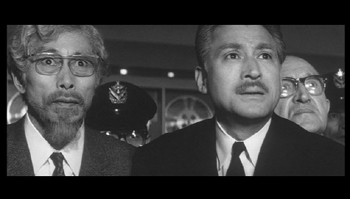 Professor Murase (Jun Hamamura) and Dr Eiji Hidaka (Eiji Funakoshi) are so shocked by the arrival of Gamera that they forget how to speak English. © 1965 Kadokawa Pictures, Inc.
Professor Murase (Jun Hamamura) and Dr Eiji Hidaka (Eiji Funakoshi) are so shocked by the arrival of Gamera that they forget how to speak English. © 1965 Kadokawa Pictures, Inc.The only big criticism of the disc is one that cannot be entirely placed upon the shoulders of Shout! Factory: that is the exclusion of the US version GAMMERA THE INVINCIBLE which had new scenes shot with actors Albert Dekker and Brian Donlevy. Sadly, Kadokawa had no materials to loan Shout! Factory for the US cut. UCLA’s Film Archives do have materials for GAMMERA THE INVINCIBLE (previously used for a VHS release of the film), and the university was approached for the inclusion of their print on the DVD. Things looked good at first, but unfortunately UCLA reportedly wanted a large sum of money to use the print which was more than Shout! Factory was willing or possibly even able to afford. It is a shame that the powers that be over at the film archives were that short-sighted when they could have contributed to make this DVD even better. There is also no inclusion of the English dubbed version released in the US by Sandy Frank, which would have been great for completion’s sake despite the poor reputation of those dubs. In a previous interview for SciFi Japan, Cliff Macmillan – vice president of DVD productions and acquisitions for Shout! Factory – said that they would check into the availability of the Sandy Frank dubs. It is unknown if it was simply decided not to include it or if the materials were unavailable. So yes, a big disappointment is the lack of either the re-shot English version or the Sandy Frank print or audio track. Is it reason to not buy the disc though? Absolutely not.
THE BOTTOM LINE
This DVD is superbly done. Complaints are minimal when all things (including the situation with the dubbed versions mentioned above) are considered. Shout! Factory has taken considerable care in putting together a quality product that is not only worthy of Gamera fans, but Japanese monster fans in general. With GAMERA VS.BARUGON recently released and double feature DVDs of GAMERA VS. GYAOS/GAMERA VS. VIRAS and GAMERA VS. GUIRON/ GAMERA VS. JIGER announced for September 21st, fans will have a lot to look forward to. Shout! Factory is doing an excellent job and deserves the support of the fans. Pick this disc up!
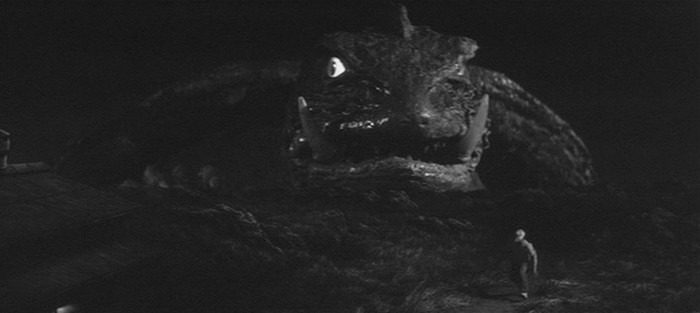 Gamera (literally) looks down on the disturbed young boy, Toshio (Yoshiro Uchida). © 1965 Kadokawa Pictures, Inc.
Gamera (literally) looks down on the disturbed young boy, Toshio (Yoshiro Uchida). © 1965 Kadokawa Pictures, Inc.

